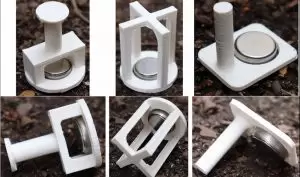Australian researchers have created a robot that can traverse burrows looking for mites that cause disease in wombats.
Built by La Trobe University engineering professor Robert Ross, in conjunction with a team at the University of Tasmania, WomBot weighs roughly two kilograms and has proven extremely useful to scientists.
“WomBot is a teleoperated robot, which means we can control it from the surface,” Ross told create.
“The idea behind WomBot is to understand the climate inside wombat burrows. It’s an environment we don’t understand very well and because of that we’re struggling to address diseases impacting wombats, such as mange.”
Wombat burrows can be up to 30 metres long, and their complexity, not to mention size, makes them nearly impossible for adult humans to traverse.
But with its tank-like treads, WomBot can manoeuvre through them with relative ease.
Building WomBot
WomBot initially had three wheels like a tricycle, but as wombat burrows tend to retain water, they can get very muddy.
“We kept it fairly lightweight, using a 3D-printed chassis, and basically tank style steering,” Ross said.
“It has two large tank treads, to give us lots of grip, but also allows us to manoeuvre really quickly and turn on the spot.”
The chassis is printed from copolyester and has a rope mount that allows researchers to extract WomBot should anything happen.
The cameras on WomBot are designed to inspect sewers, meaning they’re waterproof and have wide lenses, giving researchers a better view of the burrows. And cameras at the front and back of the robot let researchers reverse without having an accident.
Checking the climate
What makes WomBot really stand out are the range of environmental sensors it uses.
Not only are there temperature and climate sensors on board, but the robot also has a gripping hand that allows it to leave sensors in the burrow.

“Rather than just taking instantaneous measurements, we can actually place a little sensor down there and leave it for 24 hours and then retrieve it later on and look at the environmental conditions over time,” Ross said.
The data loggers scientists use to gather important information on wombat burrows are too small for WomBot to collect on its own, so the team 3D-printed holders for them to give WomBot something to grab onto.
They tested three designs they called the ‘flat-top’, ‘lattice’ and ‘pole’.
“One of our trials was a usability trial to make sure that we can actually pick these things up, both when they’re standing up and when they’re tipped over,” Ross said.
“We ended up going with the lattice one. It was the easiest one to pick up and the most reliably picked up from all angles.”
Saving the wombats
WomBot’s developers tested it in burrows in Victoria and Tasmania. What they discovered from the Tasmanian trials was that wombat burrows tend to be high in humidity — ranging between 82 and 90 per cent relative humidity — and cool, averaging about 15 degrees Celsius.
While this is the perfect climate for wombats, it does have one drawback.
“One of the consequences of this, from a wildlife ecology point of view, is that these are ideal conditions for the mites to stay alive off a host,” Ross said.
When Sarcoptes scabiei mites bury into the skin of a wombat, it initially causes itchiness but can lead to hair loss and sore and infected skin.
Despite being nocturnal creatures, wombats with a severe case of Sarcoptic mange can often be spotted foraging during the day. The increased time spent scratching their skin to relieve the itchiness from the mites leaves them less time to go foraging for food.
Hopefully future iterations of WomBot will be able to help combat this condition.
“We’ll be potentially looking at collecting soil samples from burrows and actually looking for evidence of mite infestation within the burrows and where that infestation might occur,” Ross said.
“We could also include some sort of a treatment mechanism within there. Maybe spraying some sort of insecticide within the burrows.”
The question remains, however, what do the wombat’s think of WomBot?
“We did run into one wombat,” Ross said, laughing. “It was sleeping so we let it be.”
Since real wombats are about 10 times larger than WomBot, maybe this was for the best.